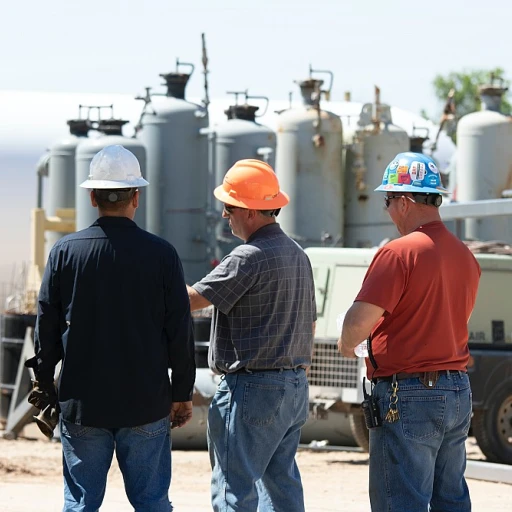
What is the office of emergency management?
Understanding the definition and function of the office of emergency management (OEM)
The office of emergency management (OEM) is often the unsung hero during crises. OEM is a specialized organization within local, state, or federal levels of government, tasked with coordinating and managing emergency preparedness, response, recovery, and mitigation activities in times of disasters. The primary goal of OEM is to ensure public safety and the effective coordination of emergency services and resources.According to the Federal Emergency Management Agency (FEMA), OEM operates under the National Incident Management System (NIMS), which standardizes the processes and procedures for disaster response across the United States. For instance, the Massachusetts Emergency Management Agency (MEMA) is responsible for coordinating with local county officials and federal agencies during emergencies, ensuring a cohesive response strategy.
Importance of local, state, and federal OEMs
OEM’s significance cannot be overstated. Local OEM offices play a crucial role in crafting emergency plans tailored to their community’s needs. From establishing emergency operations centers to conducting regular public safety drills, OEM's activities create a resilient infrastructure prepared to face disasters head-on. The office also focuses on implementing disaster risk reduction programs and public education campaigns to increase awareness and preparedness. This involvement spans across various levels, from local governments to the overarching strategies managed by national disaster management authorities.Addressing immediate concerns and future preparedness
Effective emergency management isn't just about immediate response but also long-term planning and recovery. OEM ensures comprehensive preparedness through continuous training, simulations, and community engagement initiatives. Agencies like the Maryland Emergency Management Agency (MEMA) actively collaborate with federal entities such as FEMA to streamline resource allocation and response efforts. Furthermore, advancements in technology now enable OEMs to better predict and mitigate the impacts of potential disasters, enhancing overall preparedness.For those interested in exploring related roles and responsibilities within an organization, the article on the job of an office manager provides insightful perspectives on how roles converge in supporting emergency management activities.
The role of OEM in emergency preparedness
Importance of strategic planning and resources
The Office of Emergency Management (OEM) plays a crucial role in ensuring that towns, cities, and regions are well-prepared to handle emergencies. Their work is all about planning and resource allocation, ensuring that every potential disaster scenario is accounted for.
Data: According to the Federal Emergency Management Agency (FEMA), approximately 25% of businesses do not reopen following a major disaster. Strategic planning and resources provided by the OEM can greatly influence these statistics, aiming to reduce the impact of disasters on communities and businesses.
OEMs typically focus on creating comprehensive emergency management plans that include risk assessment, resource management, and public education. For example, the Massachusetts Emergency Management Agency (MEMA) has developed extensive resources and guides to help local governments and organizations create and maintain their emergency management programs.
Emergency preparedness programs
Emergency preparedness is one of the core functions of the OEM. This includes training programs and drills to ensure readiness. The National Incident Management System (NIMS), initiated by the federal government, sets a standardized approach to incident management and response.
Quote: Craig Fugate, a former FEMA Administrator, once said, “The public is part of our team and needs to be part of our planning.” This highlights the significance of public participation in emergency preparedness initiatives. Engaging the community is essential for a successful response when a disaster strikes.
Example: In Washington, the local OEM collaborates with schools, businesses, and non-profits to run comprehensive emergency preparedness workshops. This not only builds community resilience but also ensures a coordinated effort during actual emergencies.
Public safety initiatives
Public safety is paramount. The OEM often coordinates with health departments, public safety agencies, and local governments to create a well-coordinated public safety plan. For instance, during the COVID-19 pandemic, the OEMs across various states played a pivotal role in disseminating information, coordinating vaccine distribution, and ensuring public compliance with health guidelines.
Case Study: The Maryland Emergency Management Agency (MEMA) set up rapid response teams to handle the pandemic response. This coordinated approach significantly improved the state's capacity to manage the health crisis, showcasing the importance of an operational OEM.
Public awareness and education
An informed public is a safer public. The OEM conducts regular campaigns to educate people on preparedness measures and survival tactics. These campaigns often include the distribution of materials, public service announcements, and community outreach programs.
A study by the International Association of Emergency Managers found that communities engaged in regular disaster preparedness education programs are 30% more likely to take proactive measures in an emergency, reducing the overall impact and enhancing community resilience.
Enhancing community education elevates public safety and opens opportunities for individual preparedness. For more detailed insights on how managed office spaces can aid in times of emergencies, consider exploring Finding Your Place with Managed Office for Rent.
Emergency response: How OEM acts during a disaster
How oem acts during emergencies
When disasters strike, the office of emergency management (OEM) becomes the nerve center for coordinating the response. Whether it’s a hurricane, an earthquake, or a terrorist attack, the OEM steps into its critical role of orchestrating efforts to manage the chaos and ensure public safety.
One of the primary functions of the OEM in a disaster is to activate the emergency operations center (EOC). The EOC acts as the command hub where all information is collected, analyzed, and disseminated. This facility is equipped to handle various aspects of the disaster situation, from resource distribution to communication with the public and media. According to a report by the Federal Emergency Management Agency (FEMA), activation of the EOC occurs in over 80% of national emergencies in the United States.
Communication and coordination
Effective communication is key in any emergency response. The OEM works closely with local, state, and federal agencies to ensure that everyone is on the same page. For instance, during Hurricane Sandy in 2012, the New York City OEM coordinated with FEMA, the National Guard, and various local agencies to provide timely information and resources to affected communities. The collaboration significantly reduced the chaos and facilitated a more organized response.
Resource allocation
Another critical role the OEM plays during a disaster is ensuring that resources are allocated where they are most needed. This could mean directing food and water supplies to shelters or mobilizing first responders to the most impacted areas. According to the Emergency Management Agency of California, effective resource allocation can reduce the impact of disasters by up to 25%.
Public information and updates
The OEM also plays a pivotal role in keeping the public informed. In a study published by the Disaster Recovery Institute International (DRI), timely and accurate information from the OEM was found to significantly reduce panic and help communities make informed decisions. The OEM utilizes various channels such as social media, radio, and television to reach as many people as possible.
Case study: hurricane katrina
An example of effective OEM intervention can be seen in the response to Hurricane Katrina in 2005. The Louisiana OEM, despite facing numerous challenges, managed to coordinate the evacuation and sheltering of thousands of people. While there were many criticisms of the overall federal response, the actions of the OEM at the state and local levels were often praised for their effectiveness and speed.
The role of the OEM in disaster management is not without challenges, but its function during emergencies is indispensable. Through effective communication, coordination, resource allocation, and public information dissemination, the OEM aims to mitigate the impact of disasters and ensure the safety and well-being of the community.
Collaboration between OEM and other agencies
Collaboration between OEM and other agencies
Coordination with various agencies is critical for the Office of Emergency Management (OEM). This collaborative approach ensures swift and effective responses during emergencies. By working closely with local, state, and federal agencies, OEMs are pivotal in managing disasters and public safety.
Synergy with federal and state agencies
When large-scale emergencies strike, OEMs often collaborate with federal entities like the Federal Emergency Management Agency (FEMA) and state authorities such as the Maryland Emergency Management Agency and the Massachusetts Emergency Management Agency. This teamwork plays a crucial role in mobilizing resources and providing relief efforts. For instance, during Hurricane Sandy in 2012, the New York City OEM worked alongside FEMA and the New York State Emergency Management Office to coordinate response and recovery operations. This synergy helped mitigate the impact of the disaster on residents.
Partnerships with local agencies
In addition to federal and state collaboration, OEMs coordinate efforts with local agencies like police departments, fire brigades, and public health offices. These partnerships are integral to ensuring cohesive management and timely response to emergencies. For example, during the 2017 wildfires in Northern California, local OEMs worked with county fire departments, law enforcement, and public health agencies to ensure evacuations, resource distribution, and healthcare provision.
Engagement with public safety and community volunteers
OEMs also rely on volunteers and nonprofit organizations, such as the American Red Cross, to aid in disaster management. Community engagement not only bolsters manpower but also reinforces the resilience of public safety operations. Following the 2004 Indian Ocean tsunami, the coordination between local OEMs and international NGOs was pivotal in mounting an efficient disaster response and providing relief to affected communities.
Integrated emergency operations centers
Emergency Operations Centers (EOCs) serve as the nerve centers for managing disasters, housing representatives from various response agencies to streamline communication and coordination. These centers often run drills and training programs to ensure preparedness. According to a FEMA report, regular EOC training enhances the responsiveness and effectiveness of emergency management, helping personnel handle real-world scenarios with confidence.
Overcoming bureaucratic hurdles
Despite the benefits of collaboration, OEMs occasionally face challenges such as conflicting protocols between agencies, jurisdictional disputes, and bureaucratic red tape. Nonetheless, the importance of cooperation is undeniable. As noted by Dr. John Applegate, an expert in emergency management, “Coordination and partnerships are the bedrock of successful disaster response and recovery.” Efforts to establish clear protocols and regular inter-agency meetings can help overcome these hurdles.
Case studies: Successful OEM interventions
Urban tornado response: Kansas City's OEM efforts
Kansas City's Office of Emergency Management (OEM) demonstrated remarkable ingenuity during the 2011 urban tornado response. In the face of destruction, coordination was paramount. Over 171 tornadoes were recorded in the United States that April, but Kansas City faced its share bravely.
One specific intervention stood out. Working closely with FEMA and the National Guard, Kansas City's OEM ensured that critical supplies reached affected areas within hours. This swift action was lauded by the Federal Emergency Management Agency (FEMA) as a model for disaster response in urban settings.
According to FEMA, approximately 40% of small businesses never reopen after a disaster (source: FEMA.gov). Learning from these figures, Kansas City's OEM focused on economic resilience by collaborating with local businesses, offering them support and resources to stay afloat. This approach not only aided recovery but also strengthened community cohesion.
New York's Hurricane Sandy relief
When Hurricane Sandy hit New York in 2012, the OEM faced unprecedented challenges. With over 2 million residents left without power and significant structural damage, the situation was dire. But the preparedness and response by New York's OEM showcased the importance of pre-disaster planning.
For instance, the OEM had pre-established shelters which could accommodate over 70,000 displaced residents. The coordination between the New York City OEM, Red Cross, and numerous local agencies ensured that aid was distributed efficiently. As reported by CNN, within three days, all residents had access to emergency services, underscoring the critical role of OEM in managing large-scale disasters (source: CNN.com).
Massachusetts emergency management agency's (MEMA) snowstorm response
In 2015, a record-breaking snowstorm hit Massachusetts, depositing over 100 inches of snow, and MEMA rose to the occasion. Notably, the agency utilized its Emergency Operations Center (EOC) to coordinate with local utilities, ensuring that power outages were resolved swiftly, benefiting nearly 500,000 residents. MMS Newscast named the MEMA response as a "textbook example" of effective crisis management.
MEMA also prioritized vulnerable populations, coordinating with public health agencies to ensure that the elderly and disabled received necessary care. This proactive approach mitigated the health impact significantly, a lesson for other states’ OEMs.
Collaboration with maryland emergency management agency during covid-19
The COVID-19 pandemic tested the limits of emergency management. In Maryland, the OEM's collaboration with the Maryland Emergency Management Agency (MEMA) was crucial. According to the Johns Hopkins University report, Maryland effectively established mass vaccination sites through joint efforts with MEMA.
Over 70% of Maryland residents were vaccinated by early 2022, reflecting a well-coordinated response. The success hinged on OEM's ability to adapt existing emergency frameworks to the unique challenges posed by the pandemic (source: HopkinsMedicine.org).
The Maryland case highlights the importance of flexibility in emergency management and the impact of strong inter-agency collaboration.
These examples underline how OEMs are essential for public safety and community resilience, demonstrating the successful application of preparedness, response, and collaboration in real-world scenarios.
Challenges faced by the OEM
Specific hurdles that challenge the OEM
The Office of Emergency Management (OEM) faces numerous challenges that can impact its efficacy in managing disasters and emergencies. Let’s break down some of the main ones:
Limited funding and resource allocation
One of the most significant challenges is the limited funding and resource allocation. According to a National Emergency Management Association (NEMA) survey in 2021, 74% of respondents said their agencies lacked the necessary financial resources to effectively carry out their responsibilities. This scarcity can hinder OEM’s ability to implement comprehensive disaster management plans and conduct adequate training programs.
Inter-agency coordination
Coordination among various agencies, including federal and local entities, can be cumbersome. For example, after Hurricane Katrina, the Federal Emergency Management Agency (FEMA) faced criticism for its delayed response, largely attributed to poor communication and coordination among various agencies. Ensuring smooth collaboration between different stakeholders requires streamlined communication channels and clearly defined roles, which isn't always straightforward.
Technological hurdles
The technological landscape of emergency management is ever-evolving. Keeping up with cutting-edge disaster management technologies can be taxing for OEMs, especially given the limited budgets. A report from the International Association of Emergency Managers (IAEM) revealed that only 32% of OEMs felt adequately equipped with modern technological tools and software. This gap directly impacts their efficiency in emergency preparedness and response.
Public expectations and scrutiny
Citizens expect instant and robust responses during emergencies, often leading to scrutiny when things don’t go according to plan. Social media adds another layer of challenge, where real-time information flow can either support or sabotage OEM efforts. Managing public perception and maintaining trust can be particularly challenging, as seen in the diverse public reactions during the COVID-19 pandemic.
Climate change and increasing frequency of disasters
Climate change has resulted in more frequent and severe natural disasters. Data from the United Nations Office for Disaster Risk Reduction (UNDRR) showed that climate-related disasters have grown by 83% in the past 20 years. This increase strains OEM’s capacity and resources, requiring them to continuously adapt and scale up their operations.
Addressing these challenges requires innovative solutions, strategic partnerships, and robust planning frameworks. Despite these hurdles, OEM remains a critical component in safeguarding public safety and mitigating the impact of disasters.
Public safety and community involvement
Engaging communities for better preparedness
Public safety is a core mission for the Office of Emergency Management (OEM), and community involvement is a crucial aspect of achieving this. A well-informed and prepared community can greatly reduce the impact of disasters. Various studies, including a 2022 report by the Disaster Recovery Institute International, highlight that communities with active engagement in preparedness programs experience fewer casualties and quicker recovery times (DRII, 2022).
Educating the public to foster resilience
One of the primary ways OEM enhances public safety is through education and training. This includes public awareness campaigns, which the Federal Emergency Management Agency (FEMA) has shown to be effective in increasing individual and household preparedness. For example, the Community Preparedness Pilot Program launched by FEMA in 2021 resulted in a 25% increase in emergency plan development among participants.
Implementing local preparedness plans
Local governments often partner with OEM to develop and implement preparedness plans tailored to their specific needs. The Massachusetts Emergency Management Agency (MEMA) serves as a prime example of state-level collaboration, offering resources and support to local jurisdictions to build robust emergency response systems (MEMA, 2022). Their efforts have been credited with significantly enhancing local disaster readiness.
Leveraging volunteer networks
A pivotal aspect of community involvement is leveraging volunteer networks. Programs like Community Emergency Response Teams (CERT) empower residents to take an active role in disaster response. According to a study by the National Institute of Standards and Technology, areas with strong CERT participation not only see increased public confidence but also demonstrate more effective initial incident responses due to localized knowledge and resources (NIST, 2021).
Promoting interagency collaborations
OEM's role in promoting interagency collaborations extends to public safety initiatives involving law enforcement, public health, and non-profit organizations. For instance, the New York City Office of Emergency Management has partnered with the Department of Homeland Security and local public health agencies to conduct joint training exercises, significantly enhancing inter-agency communication and operational readiness (NYC OEM, 2021).
The role of technology in enhancing public safety
Technological advancements are increasingly becoming integral to public safety efforts. The use of emergency alert systems, GIS mapping for disaster impact assessment, and social media for real-time information dissemination are some tools that OEMs utilize. A 2020 report from the International Association of Emergency Managers (IAEM) emphasized the importance of adopting emerging technologies to improve situational awareness and expedite response efforts (IAEM, 2020).
Future trends in emergency management
Leveraging technology for future readiness
The office of emergency management (OEM) is increasingly adopting advanced technology to improve disaster response and preparedness. By integrating artificial intelligence and machine learning, OEMs can better predict and prepare for potential disasters. For instance, AI-driven algorithms help in analyzing weather patterns, thus predicting hurricanes and other natural calamities more accurately.
According to a study by the National Emergency Management Association (NEMA), more than 70% of emergency management agencies in the United States are now using drones for disaster assessment and monitoring. This technology provides real-time data, which is crucial during a crisis.
Community-driven approaches
Public safety is not just the responsibility of the government; community involvement plays a significant role. Community-based disaster risk reduction programs are becoming more common, engaging local populations in preparedness activities. By educating and training citizens, OEMs help build resilient communities capable of withstanding emergencies.
In a successful case, the Massachusetts Emergency Management Agency (MEMA) collaborated with local councils to run emergency preparedness workshops, which have shown a 25% increase in community readiness since their inception.
Emergence of resilient infrastructure
The future of emergency management heavily relies on resilient infrastructure. Investment in robust, disaster-resistant buildings and critical infrastructure has become a priority. The Federal Emergency Management Agency (FEMA) has emphasized the importance of building codes and standards that enhance the structural integrity of buildings, thereby minimizing damage during disasters.
Furthermore, urban planning now includes considerations for emergency accessibility and utility resilience. Developing cities like New York have started integrating resilience into their planning, ensuring that transportation and communication remain operational during crises.
Integrated response systems
Inter-agency collaboration is crucial for an effective emergency response. The adoption of integrated emergency response systems ensures seamless coordination among federal, state, and local agencies. Systems like the National Incident Management System (NIMS) facilitate a unified approach to disaster management, providing a clear framework for all involved parties.
During Hurricane Katrina, the lack of coordination among agencies highlighted the necessity for a more integrated approach. Lessons learned from such incidents have shaped the current strategies for inter-agency cooperation, enhancing the overall efficacy of response efforts.
Focus on psychological preparedness
One often overlooked aspect of emergency management is psychological preparedness. Mental resilience is as crucial as physical safety. Training programs now include mental health support and stress management techniques. For instance, the Disaster Recovery Institute International (DRII) has initiated courses focused on psychological first aid as part of their emergency management training curriculum.
Understanding the emotional impact of disasters ensures that both responders and the general public are better prepared to handle the stress and trauma associated with emergencies.
The office of emergency management continues to evolve, incorporating new technologies, community engagement, and integrated systems to effectively respond to and recover from disasters. The future of emergency management looks promising, with ongoing efforts to build a more resilient and prepared society.










-large-teaser.webp)


